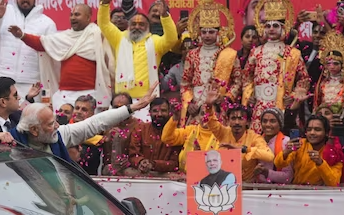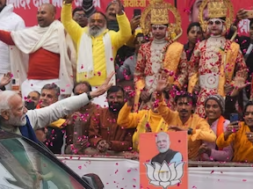
Modi Inaugurates Ayodhya Airport, Redeveloped Railway Station, Asks People not to Crowd Around at the Inauguration
Manas Dasgupta
NEW DELHI, Dec 30: Prime Minister Narendra Modi on Saturday said the whole world was waiting for the historic consecration ceremony of the Ram Temple in Ayodhya on January 22 but appealed to people in the country not to crowd around the city by coming for the event on the inaugural day.
On a day of packed programmes, Modi was addressing a public meeting after inaugurating the Maharshi Valmiki Airport and the redeveloped Ayodhya Dham railway station from where he flagged off two Amrit Bharat and six Vande Bharat trains, some virtually. He also inaugurated and laid the foundation stone of multiple development projects worth more than ₹15,700 crore.
Modi urged the public not to visit Ayodhya on January 22 for inauguration of the Ram Temple. “As bhakts, we would not like to cause any problems to Lord Ram. You all can come starting January 23 till eternity… Ram Mandir is now there forever and ever,” Modi said. The Prime Minister also asked every Indian to light a diya in their house on January 22.
Soon after arriving in Ayodhya, the Prime Minister held a roadshow during which he waved and greeted at the people who had gathered along the route from the airport to the railway station. He also witnessed performances by cultural troupes along his roadshow’s route.
The city had been decked up in flowers and posters welcoming the PM were put up in several places. A heavy security cordon was in place. A former litigant in the Ayodhya land dispute case, Iqbal Ansari, was seen showering flowers on Prime Minister Narendra Modi’s motorcade during his roadshow in the temple town on Saturday. Earlier in October this year, Ansari, emphasised that Ayodhya was a place of religious significance for Hindus, Muslims, Sikhs, and Christians, where deities from across the country are venerated.
The Prime Minister inaugurated the redeveloped railway station, which will now be called Ayodhya Dham. The three-storey structure, redeveloped at ₹ 240 crore, is a certified green building and is equipped with lifts, escalators, child care room, waiting halls, cloakrooms and food plazas.
The station’s facade has a traditional look and many aspects of the design are inspired by Lord Ram’s life as well as the Ram Temple. “The top of the station has a structure with a design that resembles a royal ‘mukut’ (crown) while a bow has been depicted on a wall just beneath it. This is to signify Ayodhya’s association with Lord Ram,” an official said.
Mr Modi also flagged off six Vande Bharat and two new Amrit Bharat trains. The Amrit Bharat trains, which are a new category of superfast passenger trains, feature the ‘push-pull’ technology, which increases their speed as well as passenger comfort. They also have improved amenities, including better seats, roomier luggage racks, LED lights, CCTV cameras and a public information system.
The Ayodhya airport, which is called the Maharishi Valmiki International Airport Ayodhya Dham, has been developed at a cost of over ₹ 1,450 crore. The airport’s terminal has an area of 6,500 sq m and will be equipped to serve about 10 lakh passengers annually. Colourful murals depicting different stages of the Ramayana and Lord Ram’s life adorn several sections of the airport
Airlines will offer flights to and from major cities like Delhi, Mumbai, Kolkata, Hyderabad, Bengaluru, Chennai, and Ahmedabad to cater to the thousands of people who are expected to visit the Ram Temple every day after the consecration ceremony.
Uttar Pradesh Chief Minister Yogi Adityanath on Friday inspected the Ayodhya railway station and the airport. Of the development works, projects worth more than ₹ 11,000 crore are for Ayodhya and its surrounding areas. The Prime Minister also inaugurated four widened and beautified roads in the city. The other projects include a medical college, the Ayodhya bypass, a solid waste treatment and five parking and commercial facilities.
Meanwhile, a total of 300 tonnes of aromatic rice was dispatched from Chhattisgarh on Saturday for the consecration ceremony. Chief Minister Vishnu Deo Sai flagged off 11 trucks carrying the rice consignment. The event, titled ‘Sughandit Chawal Arpan Samaroh’ (aromatic rice offering ceremony), was held by the Chhattisgarh Pradesh Rice Millers Association, which has offered the rice to be used as “prasad in the consecration ceremony of Shri Ram Mandir in Ayodhya,” it said. Chhattisgarh, known as a ‘rice bowl’, is considered Lord Ram’s ‘nanihal’ (the place of maternal grandparents).
The Union Home Minister Amit Shah said the consecration of Lord Ram’s idol on January 22 and the beginning of India’s ‘Amrit Kaal’ were not a mere coincidence but a sign that the country would rise to prominence on the world stage in the next 25 years. Amrit Kaal, which roughly translates to ‘golden era’, refers to the 25-year period from 75 years to 100 years of India’s independence.
The much-awaited inauguration of the Ram Temple in Ayodhya is expected to be a grand affair on January 22 and devotees from across the country have already begun visiting the site to witness the construction of the temple complex. The site is dotted with mounds of Makrana Marble brought from Rajasthan’s Bharatpur district and stone from other places that are being used in the construction of the grand temple. Nearly 8,000 dignitaries have been invited to attend the consecration ceremony and 15% of the people working at the site will also get invites.













